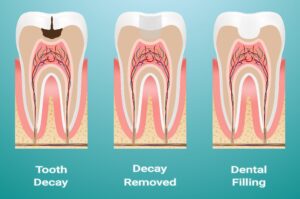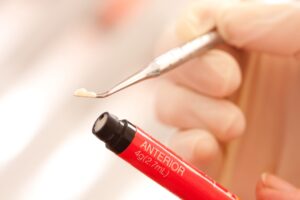Fillings vs. Cosmetic Bonding
 Many people are confused about various dental procedures because of the wide variety of terms dentists and other dental professionals use to describe them. To complicate matters even further, we use many of the same materials for different applications, technically making them different procedures. That is precisely the topic addressed in this week’s blog.
Many people are confused about various dental procedures because of the wide variety of terms dentists and other dental professionals use to describe them. To complicate matters even further, we use many of the same materials for different applications, technically making them different procedures. That is precisely the topic addressed in this week’s blog.
What are Composite Fillings?
Composite fillings are tooth-colored dental restorations used to rebuild a tooth to normal shape and function after it is damaged in some way. Usually the damage is the result of decay or trauma (cracks).
Your dentist removes any unhealthy tooth structure, and replaces it with composite resin. This tooth colored filling has an adhesive bond with the hard structures of a tooth, creating a good replacement of lost tooth structure.
What is Cosmetic Bonding?
Cosmetic bonding uses the same material: composite resin. Your dentist can perform cosmetic bonding to change the shape of your front teeth and improve the appearance of your smile.
There is typically no damage to repair. Therefore, your dentist does not have to remove tooth structure. She may perform minor recon touring or rounding of sharp edges to prepare the tooth for the bonding procedure.
How are They Different?
Fillings are restorations, meaning they restore something that is missing. The reason it is missing is the dentist removes any damaged tooth structure first. Put simply, a “filling” fills in a void or hole in a tooth.
Cosmetic bonding typically covers and reshapes a tooth in order to improve its appearance. We often use cosmetic bonding to enlarge teeth that are unnaturally or disproportionately small. We can close gaps between the teeth with cosmetic bonding. It is generally not replacing damaged tooth structure.
Because fillings are part of the overall cavity repair process, they involve drilling into the tooth, which necessitates local anesthetic. That means you typically have an injection for fillings, and your mouth is numb in the area treated.
Cosmetic bonding, because it is adding to the natural tooth, usually involves only minimal drilling. The drilling that might occur is on the superficial layer of the tooth and not into it. This means that no numbing is necessary because there is not pain or sensitivity during the process.
What are the Correct Uses of Fillings?
 Composite fillings are appropriate for restoring cavities that affect less than half of the tooth and do not reach the hollow nerve chamber in the center. The purpose of fillings is functional, so that the tooth can resume its work of chewing and preventing food from collecting between teeth.
Composite fillings are appropriate for restoring cavities that affect less than half of the tooth and do not reach the hollow nerve chamber in the center. The purpose of fillings is functional, so that the tooth can resume its work of chewing and preventing food from collecting between teeth.
We use fillings to repair damage from the following:
- Tooth decay (cavities)
- Cracked teeth
- Chipped teeth
- Acid erosion
What are the Correct Uses of Cosmetic Bonding?
Cosmetic bonding is appropriate to add to the existing shape and size of a tooth. It is primarily esthetic in nature, and it does not restore decayed or cracked teeth as a filling does. We use cosmetic bonding to correct the following smile problems.
- Teeth that are disproportionately small compared to the other teeth in the smile
- Gaps between the front teeth
- Teeth with uneven or slanted edges
- Teeth that appear to short
Why is Cosmetic Bonding More Expensive than Fillings?
 There are a few reasons that the dental procedures for cosmetic bonding may cost more than fillings. First of all, cosmetic dental treatments require more time from your dentist. Dr. Ann is a perfectionist, and she takes her time to give you ideal results. All of her restorations will be functionally correct. Adding the cosmetic dimension takes more time to precisely deliver.
There are a few reasons that the dental procedures for cosmetic bonding may cost more than fillings. First of all, cosmetic dental treatments require more time from your dentist. Dr. Ann is a perfectionist, and she takes her time to give you ideal results. All of her restorations will be functionally correct. Adding the cosmetic dimension takes more time to precisely deliver.
We typically use different materials for these two procedures. The materials necessary to restore a back tooth to function are actually less expensive than those used to create a cosmetic result. For cosmetic bonding, we use a more expensive brand of composite resin designed specifically for visible restorations, in a variety of colors and highly polishable.
More Questions about Fillings or Cosmetic Bonding?
Call Designer Smiles today to schedule a consultation with Dr. Ann. She can answer all of your questions about the difference between fillings and cosmetic bonding. She will assess your particular situation and recommend the right treatment for your specific needs.
